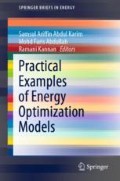Abstract
In this era of Internet of Thing (IoT) and Big Data, observations are collected not as daily, weekly, monthly, quarterly or yearly, but are taken at a finer time scale. These observations are in hourly, minutely, second and then divide into fractions of second have become available mainly due to the advancement in data acquisition and processing techniques. In this chapter, high frequency time series data of solar radiation of every 30 s will be gathered and model using Box and Jenkins methodology. This methodology comprises of model identification, model estimation, model verification and finally model adequacy.
Access this chapter
Tax calculation will be finalised at checkout
Purchases are for personal use only
References
Sayeed MA, Dungey M, Yao W (2018) High-frequency characterisation of Indian banking stocks. J Emerg Mark Financ 17:S213–S238
Zhou X, Pan Z, Hu G, Tang S, Zhao C (2018) Stock market prediction on high-frequency data using generative adversarial nets. Math Probl Eng 2018:1–11
Serjam C, Sakurai A (2018) Analyzing predictive performance of linear models on high-frequency currency exchange rates. Vietnam J Comput Sci 5(2):123–132
Guermoui M, Melgani F, Danilo C (2018) Multi-step ahead forecasting of daily global and direct solar radiation: a review and case study of Ghardaia region. J Clean Prod 201:716–734
Muzathik AM, Nik WBW, Ibrahi MZ, Samo KB, Sopian K, Alghoul MA (2011) Daily global solar radiation estimate based on sunshine hours. Int J Mech Mater Eng 6(1):75–80
Yap KW, Karri V (2012) Comparative Study in Predicting the Global Solar Radiation for Darwin, Australia. J Sol Energy Eng 134(3):1–6
Ghimire S, Deo RC, Downs NJ, Raj N (2019) Global solar radiation prediction by ANN integrated with European Centre for medium range weather forecast fields in solar rich cities of Queensland Australia. J Clean Prod 216:288–310
Ozoegwu CG (2018) The solar energy assessment methods for Nigeria: the current status, the future directions and a neural time series method. Renew Sustain Energy Rev 92:146–159
Alsharif MH, Younes MK, Kim J (2019) Time series ARIMA model for prediction of daily and monthly average global solar radiation: the case study of Seoul, South Korea. Symmetry 11:1–17
Adejumo AO, Suleiman EA (2017) Application of ARMA-GARCH models on solar radiation for south southern region of Nigeria. J Inform Math Sci 9(2):405–416
Fortuna L, Nunnari G, Nunnari S (2016) Nonlinear modeling of solar radiation and wind speed time series. Springer International Publishing, Switzerland
Sun H, Yan D, Zhao N, Zhou J (2015) Empirical investigation on modelling solar radiation series with ARMA-GARCH models. Energy Convers Manag 76:385–395
Ozoegwu CG (2019) Artificial neural network forecast of monthly mean daily global solar radiation of selected locations based on time series and month number. J Clean Prod 216:1–13
Mukaram MZ, Yusof F (2017) Solar radiation forecast using hybrid SARIMA and ANN model: a case study at several locations in Peninsular Malaysia. Malays J Fundam Appl Sci Spec Issue Some Adv Ind Appl Math 2017:346–350
Palma W (2007) Long-memory time series: theory and method. Wiley, Hoboken
Beran J, Feng Y, Ghosh S, Kulik R (2013) Long-memory processes: probabilistic properties and statistical methods. Springer, Heidelberg
Doornik JA, Ooms M (2003) Computational aspects of maximum likelihood estimation of autoregressive fractionally integrated moving average models. Comput Stat Data Anal 42:333–348
Box GEP, Jenkins GM, Reinsel GC, Ljung GM (2015) Time series analysis: forecasting and control, 5th edn. Wiley, Hoboken
Author information
Authors and Affiliations
Corresponding author
Editor information
Editors and Affiliations
Rights and permissions
Copyright information
© 2020 The Author(s), under exclusive license to Springer Nature Singapore Pte Ltd.
About this chapter
Cite this chapter
Ismail, M.T., Karim, S.A.A. (2020). Time Series Models of High Frequency Solar Radiation Data. In: Karim, S., Abdullah, M., Kannan, R. (eds) Practical Examples of Energy Optimization Models. SpringerBriefs in Energy. Springer, Singapore. https://doi.org/10.1007/978-981-15-2199-7_6
Download citation
DOI: https://doi.org/10.1007/978-981-15-2199-7_6
Published:
Publisher Name: Springer, Singapore
Print ISBN: 978-981-15-2198-0
Online ISBN: 978-981-15-2199-7
eBook Packages: EnergyEnergy (R0)

